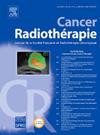Evaluation of 30-day mortality after palliative radiotherapy of 8 Gy in a single fraction as a quality criteria of patient management in a university hospital
IF 1.4
4区 医学
Q4 ONCOLOGY
引用次数: 0
Abstract
Purpose
Palliative radiotherapy aims to relieve cancer-related complications (pain, bleeding, external compression) and improve patients’ quality of life. The 8 Gy single-fraction regimen is the most commonly used, as it is effective and convenient to patients. Given that the therapeutic effect of palliative radiotherapy may take several weeks to manifest, a 30-day mortality rate below 16 % is considered a quality criteria, since a higher mortality rate would indicate overtreatment of patients who would not benefit from radiotherapy. Our objective was to determine the 30-day mortality rate following single-fraction 8 Gy palliative radiotherapy in the radiotherapy department of Pitié-Salpêtrière hospital (Paris, France) during the year 2023.
Material and method
We conducted a retrospective study including patients treated between January 2nd and December 31st, 2023, regardless of the primary cancer type or the indication for palliative radiotherapy. Mortality was assessed 30 days after radiotherapy. Factors associated with earlier death were analysed using univariate and multivariate analyses, including the following variables: primary cancer type, gender, 3–4 performance status (according to the World Health Organisation), number of systemic treatment lines received, radiotherapy indication, need for hospitalization, and multiple irradiation sites.
Results
A total of 125 patients were included in the study. Among them, 18 patients (14.4 %) received two treatments within the year, leading to a total of 143 radiation treatments delivered. Radiotherapy was primarily intended for pain relief in more than 86 % of cases (94 % for bone metastases, 6 % for epiduritis), while haemostatic and decompressive indications accounted for 3 % of cases each. In this cohort, the 30-day mortality rate was 11 %. However, in the subgroup of 11 patients treated with haemostatic intent, the 30-day mortality rate was significantly higher (46 %). A performance status greater than 2 was significantly associated with a higher 30-day mortality rate (odds ratio: 2.6, P < 0.01).
Conclusion
Our study estimates the 30-day mortality rate at 11 % following single-fraction 8 Gy palliative radiotherapy among the 125 patients treated for this indication at Pitié-Salpêtrière Hospital in 2023. This study demonstrates the feasibility of using this simple quality criteria as an indicator for internal or external audit evaluations.
某大学医院作为病人管理质量标准的姑息性放疗后30天死亡率评价
目的姑息性放疗旨在缓解肿瘤相关并发症(疼痛、出血、外压),提高患者的生活质量。8gy单组分方案是最常用的,因为它对患者有效且方便。鉴于姑息性放疗的治疗效果可能需要数周才能显现,30天死亡率低于16%被认为是质量标准,因为较高的死亡率将表明对无法从放疗中获益的患者进行了过度治疗。我们的目标是确定2023年期间Pitié-Salpêtrière医院(法国巴黎)放疗部接受单次8 Gy姑息放疗后30天的死亡率。材料与方法我们对2023年1月2日至12月31日期间接受治疗的患者进行了回顾性研究,无论原发癌症类型或姑息性放疗的指征如何。放疗后30天评估死亡率。使用单变量和多变量分析分析与早期死亡相关的因素,包括以下变量:原发癌症类型、性别、3-4性能状态(根据世界卫生组织)、接受的全身治疗线数、放疗指征、住院需要和多个照射点。结果共纳入125例患者。其中18例(14.4%)患者在一年内接受了两次治疗,共进行了143次放射治疗。放疗主要用于缓解超过86%的病例的疼痛(94%用于骨转移,6%用于硬膜外炎),而止血和减压指征各占3%。在这个队列中,30天死亡率为11%。然而,在有止血意图的11例患者的亚组中,30天死亡率明显更高(46%)。性能状态大于2与较高的30天死亡率显著相关(优势比:2.6,P <;0.01)。结论:我们的研究估计,2023年在Pitié-Salpêtrière医院接受单次8 Gy姑息放疗的125例患者的30天死亡率为11%。本研究证明了使用这一简单的质量标准作为内部或外部审计评价指标的可行性。
本文章由计算机程序翻译,如有差异,请以英文原文为准。
求助全文
约1分钟内获得全文
求助全文
来源期刊

Cancer Radiotherapie
医学-核医学
CiteScore
2.20
自引率
23.10%
发文量
129
审稿时长
63 days
期刊介绍:
Cancer/radiothérapie se veut d''abord et avant tout un organe francophone de publication des travaux de recherche en radiothérapie. La revue a pour objectif de diffuser les informations majeures sur les travaux de recherche en cancérologie et tout ce qui touche de près ou de loin au traitement du cancer par les radiations : technologie, radiophysique, radiobiologie et radiothérapie clinique.
 求助内容:
求助内容: 应助结果提醒方式:
应助结果提醒方式:


